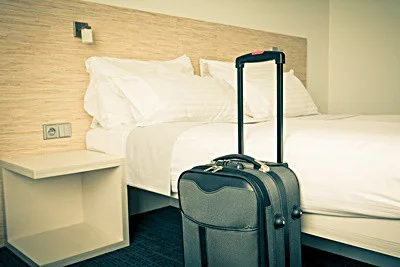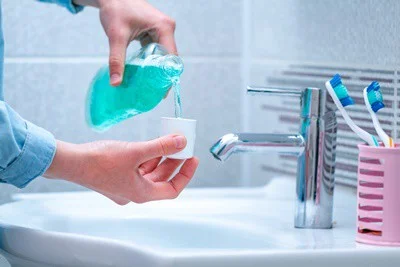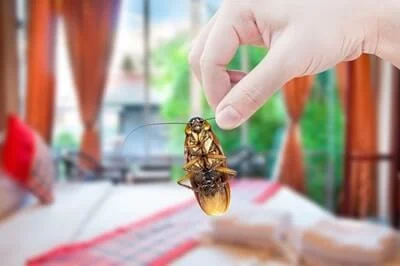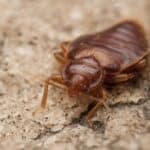Regardless of how well you pack your baggage and how clean you are, cockroaches can get into the smallest spaces without you even realizing it. So, how can you check your luggage for signs of cockroaches?
To look for cockroaches in your luggage, check for damage to your clothes and toiletries because roaches eat them. Musky odors, stains, shed exoskeletons, and feces are signs of cockroaches. As soon as you return from your vacation, wash all of your clothes on a full cycle at a temperature of over 125 degrees.
Cockroaches hide in suitcases because they’re warm and dark, protecting them from harm. If you do find a cockroach in your suitcase, it’s likely to be alone, but this isn’t guaranteed. So, keeping checking in any narrow hiding spaces.
Do Cockroaches Get Into Luggage?
Unfortunately, cockroaches can get inside virtually anything if there’s a good enough opportunity. While your luggage is packed away under a hotel bed or in your holiday home’s wardrobe, cockroaches can crawl inside.
Cockroaches prefer to live in places that are warm and dark, which suitcases provide. If the luggage is located close to a food and water source, such as a hotel bathroom, the roach will use your luggage as its base, making frequent shuttle runs to eat and drink.
The most likely reason you have roaches in your luggage is that it’s snuck into your luggage while it’s been temporarily stored. When you come to pack your bags to go home, you might not notice them, so they’ll hide inside the clothes that you pack away.
Similarly, if you’re staying in a hotel or holiday rental with a roach infestation, these resilient pests can get inside your unpacked bags, setting up home inside your luggage.
As a result, there’s a risk that you’ll introduce cockroaches to your home when you return from vacation. This increases the chances of a cockroach infestation, especially if more than one cockroach has gotten into your bag.
Can Cockroaches Travel In Suitcases?
If you have a suitcase with fabric slip pockets that can’t be secured by a zip or popper fastening, a cockroach could easily hide inside without detection. Similarly, once the clothes are inside the bag, cockroaches hide amongst them where they are protected.
While a plane’s cargo hold gets very cold, cockroaches hibernate for the duration of the flight. They’re able to survive because of the clothes and the fabric that lines the suitcase – all of which generate warmth that keeps the roach’s body temperature stable.
If you’re traveling home by plane, train, or any other transport method, cockroaches will likely survive the trip because it doesn’t have to deal with extreme temperatures.
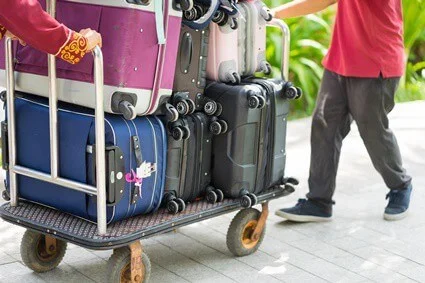
Do Cockroaches Eat Suitcases?
Most suitcases are made from a fabric lining to protect the clothes and items inside. While cockroaches eat other foods before fabric, they eat all kinds of organic matter to stay alive.
Similarly, if there are food stains or drink spills on your clothes or inside your suitcase, roaches will feast on them, chewing holes and creating stains.
They’re also attracted to body fluid stains caused by sweat and BO and laundry starch, which is a primary food source for roaches. After a long vacation, some of your clothes are likely to smell.
Even if you use plastic bags to keep your clothes safe, roaches can chew through tough materials, including plastics. As described by Plos One, cockroaches have an impressive bite strength due to their powerful mandibles or jaws.
Do Cockroaches Lay Eggs In Luggage?
Cockroaches lay their eggs inside luggage if they feel it’s a safe place for them. Suitcases offer plenty of crevices that shelter and protect the eggs. Coupled with the warm and dark conditions, there’s not really a better hiding place than a suitcase.
Similarly, cockroaches enjoy nesting in places that absorb their odors. Fabric-lined luggage or suitcases used to store clothes soak up the smells, allowing cockroaches to remain inside undetected. Cockroaches lay multiple eggs at a time in an ootheca, which is a single casing.
They’re usually dark or reddish-brown and range between 5 mm to 13 mm long. If you notice eggs, you’re at serious risk of an infestation.
Are Cockroaches In My Luggage?
If you suspect you have cockroaches in your luggage, look out for the following things before you re-pack to go home:
Smells
Cockroaches store uric acid in their fat, which smells unpleasant. Similarly, they give off pheromones to communicate with their colony. If the suitcase they’re living in is a good home, they’ll alert others.
If your suitcase has been stored in the same place for a while during your vacation, the odor will likely be noticeable as soon as you open the case up. Expect to find an oily, musty smell that gets worse over time.
Feces
Feces are another tell-tale sign that cockroaches have gotten inside your luggage. Roaches leave droppings everywhere. They look like tiny black or brown dots that are similar to coffee granules.
Even if you’re only away from home for a few days, you’ll notice the droppings. Lots of feces mean that a group of cockroaches has made the luggage their home. However, only a few small droppings indicate that a lone roach is living there.
Stains
As cockroaches scuttle, they leave brown smear marks that are usually long or irregularly shaped. They contain harmful pathogens that can make humans and animals unwell, so don’t touch them with your bare hands to avoid getting sick.
Damage
Bite marks or scratches inside plastic luggage are both signs that cockroaches are living inside.
As mentioned, cockroaches eat fabric if no other food sources are available, so fabric-lined luggage is likely to have pieces missing. This is especially the case with natural materials, such as cotton and linen.
How To Prevent Cockroaches From Getting In Your Suitcase
To prevent unwanted hitchhikers from coming home with you, you must work on preventing cockroaches in luggage in the first place.
There are things you can do to minimize the risk of roaches, but you’ll need to be mindful of where you’re placing your suitcase at all times during your journey home. This is tricky, especially if you’re traveling by plane. That being said, to keep cockroaches out of your luggage, follow these steps:
Cockroach-Friendly Luggage
Wherever possible, opt for either a washable bag or hard-shell suitcase. Washable bags aren’t the most suitable for long-haul trips as they’re not big enough, but they’re the ideal size for weekends away. As soon as you get the bag home from vacation, wash it on a high heat to kill pests and their eggs.
In comparison, hard-shell cases are impossible for roaches to get through if they’re stored properly and zip-locked at all times while in your hotel room.
Keep Food Out
While it’s tempting to pack local sweets and delicacies to take home, you’re only attracting cockroaches and giving them easy access to the sustenance they need to survive.
If you’re taking them home as presents for family and friends and can’t leave them behind, make sure they are tightly stored in an air-locked container that cockroaches can’t get into.
Be mindful that cockroaches will eat through organic items, like cardboard boxes and teabags. This is because they’re made with starch. A cockroach’s digestive tract harbors protozoa and bacteria that allow them to digest non-food items.
Soap
Keep all toiletries, especially soap and toothpaste, securely packed away in a hard-shelled bag. Both of these items contain starch, which, as mentioned, cockroaches feast on.
Cockroaches will chew through fabric bags to get to the contents inside, so try to pack them in something durable to keep them safe. Similarly, don’t leave these items loose amongst your clothes, as cockroaches will eat them along with your garments.
Don’t Leave The Suitcase on The Floor
When you arrive at your hotel or holiday destination, don’t let your suitcase touch the floor. Put it on a table and leave them there for the duration of your vacation.
The reason is that cockroaches tend to hide in the smallest nooks and crannies that you can’t see. Keeping your suitcase in a higher position means roaches have to climb to reach them, allowing you to keep a better eye on any pests inside the room.
This reduces the chances of contact between your luggage and any roaches in the room and stops any cockroaches from coming home with you.
Examine The Hotel Room
Before you head out to explore the local area, perform a thorough check of your hotel room for any signs of cockroaches. Check inside all drawers and wardrobes and down the backs of the furniture.
Also, don’t forget to give the bathroom a thorough once-over. Many cockroaches live in bathrooms where the water’s abundant. For that reason, check around all the pipes, behind the toilet, and all around the shower and drain in case cockroaches are lurking.
If you do spot roach signs, report it to the front desk and ask for a room that’s further away. That’s because if one room is infected, there’s a high possibility that the adjacent rooms are, too. You don’t want to risk cockroaches getting inside your suitcase from an infested hotel room.
Wrap The Suitcase In Plastic
While we realize this isn’t the most fun thing to do on your holiday, wrapping your suitcase in plastic or cling film for the duration of your holiday will suffocate any hidden roaches that may have gotten in before you go home. It also prevents them from accessing the luggage altogether.
This isn’t a fool-proof method, but it definitely reduces the risk of unwanted pests getting inside your bag.
How To Get Rid Of Cockroaches In Luggage
If cockroaches have already gotten into your luggage while you were vacationing, you’ll need to get rid of them as soon as possible to prevent an infestation inside the house when you return home. If you see the pests inside your suitcase, be careful not to touch them with your bare hands.
According to the World Health Organization, roaches spray pungent chemicals to protect themselves against predators. Not only are they foul-smelling, but they cause the following reactions:
- Dermatitis
- Itching
- Swelling of the eyelids
- Serious respiratory conditions
To get rid of cockroaches from a suitcase, follow these steps:
Carefully Unpack
The first step is to carefully unpack your clothes, checking each garment for signs of cockroaches. Turn each item of clothing inside out and vigorously shake them to remove any pests.
Even if you don’t see any roaches, wash all clothes regardless of whether they’re dirty or not. Machine wash them on the highest heat you can without shrinking the clothes, as this will kill the eggs (if there are any).
Don’t put any of your clothes back into the suitcase for storage until you’ve dealt with the entire problem. Otherwise, you risk infecting the clothes you’ve just sanitized along with the rest of your wardrobe.
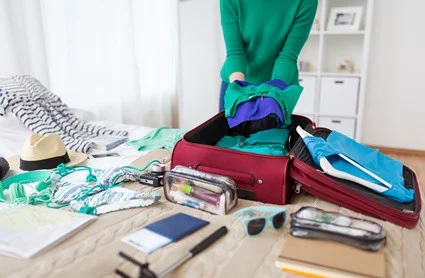
Spray The Suitcase With Roach Killer
As soon as you notice you have cockroaches inside your luggage, get a pet-safe cockroach pesticide and use it to spray the inside and outside of your suitcase. Leave it to work for a few hours before inspecting the bag again.
This will deal with the problem if you only have one lone roach, but it may not be enough to treat an infestation. Similarly, it may not kill the eggs.
Another less abrasive way to deal with cockroaches is to sprinkle the suitcase with diatomaceous earth. The powder scratches the cockroaches’ exoskeletons, absorbing essential oils and dehydrating them to death.
Taking preventative measures as soon as you reach your vacation destination is the best way to ensure that luggage and clothes are protected from cockroaches and unwanted pests.
